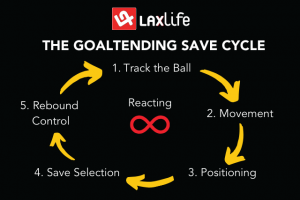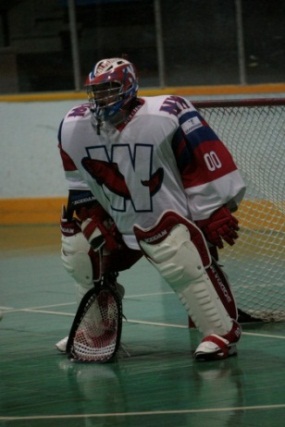
Fundamental Skills Analysis
Goaltending:
- Goalie “Ready” Position/Goalie Stance/“Stick Hand”: Goalies are the last line of defense and as such should always be “ready” and focused, especially when the ball enters the defensive zone. Standing in the “athletic position” with feet hip width apart (on the “balls” of one’s feet, feet pointed slightly outward), the goalie’s upper body should be upright with a slight forward bend and lower body have knees slightly bent; the large majority of the time. Think "balance, body (standing big) & step," before and after the shot; remember to "breathe," as NLL Hall of Famer Dallas Eliuk used to write on his stick.
Goalies should strive to stay on their feet (for maximum net coverage) while keeping their “eyes on the ball” and constantly re-positioning to “square up” (align) with the ball carrier's stick head, as best as possible (see “5 standard angles”). They should hold their goalie stick in their dominant hand, just above the “goalie knob;” ideally with the hand that would be their top hand while passing (quicker transition: rebound control -> throwing position -> pass execution).
The “stick hand” should be holding the shaft firm, halfway down the goalie’s thigh, tight to their body and they should be leaning on the stick slightly (positioned 3 to 6 inches in front of their feet); "dragging the stick" whenever moving. The “shaft” of the stick should pass between the goalie's elbow and body, with the arm-pit becoming a lever in aiding with the movement of the stick; the rest of the shaft coming out behind the goalies shoulder and against the cross-bar when close to the net. The glove hand should then be placed beside the hip with one’s elbow slightly bent creating an "arm triangle" that covers up the “six-hole,” otherwise used to reach to save perimeter shots.
In its entirety, described above is the "goalie stance," which is where most of the bad habits a goalie may develop will lie.
- Tracking The Ball/Tracking Passes/Tracking Rebounds/“Eyes On The Ball” (See Goaltending Drill #1): Alongside always being in the ready position, the number one priority of a goaltender is to always “track the ball” until oneself or one’s teammate has corralled the loose ball. The odd time teams will attempt to challenge a goalie’s mental focus in this regard when they perform a “hidden ball trick.”
As with “finishing a check” for a player, finishing the play if you’re a goalie means to track the ball until it is in your pads, otherwise “tracking rebounds” and always repositioning to the proper angle (all of which are the most important habits related to the position of a goaltender). Goalies need to stay patient while "tracking passes" and before "selling out" on a save; they will find themselves out of position if they are too reactive.
Whenever a player gets "in tight" with the ball, the goalie should be starring at the players stick, magnifying their focus and reading the body language of the shooter.
- Goalie Triangle/Goalie Footwork: In order for goalies to be sure that they have the “angle” of the ball carrier covered they must know exactly where to stand, constantly repositioning (sometimes inches at a time depending on the movements of the ball carrier), getting “ready” and “square” depending on the “5 standard ball positions.” For the most part, they should never venture out of a “tight triangle” spanning from left crease ball position (feeling for posts), up to top centre ball position (“1½ steps” off of the goal-line) and over to "right crease ball position."
Goaltender movements should be made using shuffle steps, unless the ball is passed on a diagonal from side-to-side (east- west) or crease-to-crease (GLE). In this and other “desperation” scenarios, the goalie may also need to “lunge” (drop-step) across the net and at times swing their stick over to stop quick stick opportunities. Having said that, quick “footwork” and anticipation should be relied upon most in order to stop a shot that is a product of quick east-west ball movement. As an offensive player gets "in tight" on the goalie they should start to move progressively backward toward the goal-line.
- Categories: Beginner / Free / Drillbook / Goaltending

